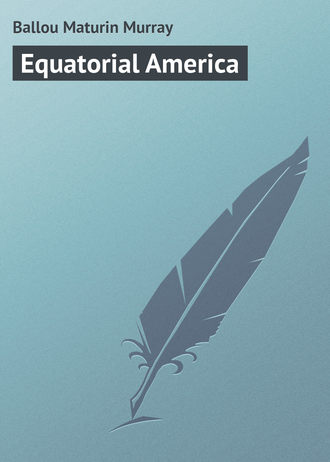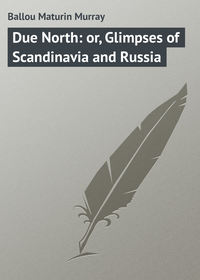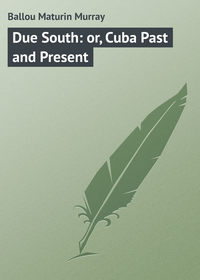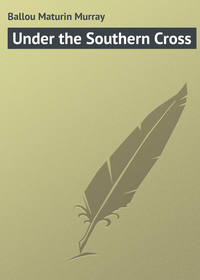 полная версия
полная версияEquatorial America
The largest diamond yet discovered came from Brazil, and is known as the Braganza. The first European expert in precious stones has valued this extraordinary gem, which is still in the rough, at three hundred million sterling! Its actual weight is something over one pound troy. In the light of such a statement, we pause to ask ourselves, What is a diamond? Simply carbon crystallized, that is, in its greatest purity, and carbon is the combustible principle of charcoal. The author was told, both here and in Rio Janeiro, that there is a considerable and profitable mining industry carried on in this country, of which the general public hear nothing. The results are only known to prominent and interested Brazilians, the whole matter being kept as secret as possible for commercial reasons. No one reads anything about the products of the diamond mines in the local papers.
We cannot say that the city of Bahia is a very healthy locality, though it certainly seems that it ought to be, it is so admirably situated. Yellow fever and other epidemics prevail more or less every year. The lower part of the town, on the water front, is so shamefully filthy as to induce fever. Upon first landing, the stranger finds himself almost nauseated by the vile smells which greet him. This section of the town is also very hot, the cliff, or upper town, shutting off almost entirely the circulation of air. It is here that sailors, particularly, indulge in all sorts of excesses, especially in drinking the vile, raw liquor sold by negresses, besides eating unripe and overripe fruit, thus inviting disease. One favorite drink produced here, very cheap and very potent, is a poisonous but seductive white rum.
The trade and people in this part of the town form a strange conglomerate, – monkeys, parrots, caged birds, tame jaguars, mongrel puppies, pineapples, oranges, mangoes, and bananas, these being flanked by vegetables and flowers. The throng is made up of half-naked boatmen, indolent natives from the country, with negresses, both as venders and purchasers. As we look at the scene, in addition to what we have depicted there is a jovial group of sailors from a man-of-war in the harbor enjoying their shore leave, while not far away a small party of yachtsmen from an English craft are amusing themselves with petty bargains, close followed by half a dozen Americans, who came hither in the last mail steamer. A polyglot scene of mixed tongues and gay colors.
In passing into and out of the harbor of Bahia, one can count a dozen forts and batteries, all constructed after the old style, and armed in the most ineffective manner. These would count as nothing in a contest with modern ships of war having plated hulls and arms of precision. Land fortifications, designed to protect commercial ports from foreign enemies, have not kept pace with the progress in naval armament.
Bahia is connected by submarine telegraph with Pernambuco, Pará, and Rio Janeiro, and through them with all parts of the civilized world.
CHAPTER VIII
Cape Frio. – Rio Janeiro. – A Splendid Harbor. – Various Mountains. – Botafogo Bay. – The Hunchback. – Farewell to the Vigilancia. – Tijuca. – Italian Emigrants. – City Institutions. – Public Amusements. – Street Musicians. – Churches. – Narrow Thoroughfares. – Merchants' Clerks. – Railroads in Brazil. – Natural Advantages of the City. – The Public Plazas. – Exports.
After a three days' voyage down the coast, between Bahia and Rio Janeiro, the tall lighthouse of Cape Frio – "Cool Cape" – was sighted. This promontory is a large oval mass of granite, sixteen hundred feet in height, quite isolated from other highlands, protruding boldly into the Atlantic Ocean. It forms the southeastern extremity of the coast of Brazil, and in clear weather can be seen, it is said, forty miles or more away. Here the long swell of the open sea is unobstructed and finds full sway, asserting its giant power at all seasons of the year. Experienced travelers who rarely suffer from seasickness are apt to succumb to this trying illness off Cape Frio. It is situated in latitude 22° 59' south, longitude 41° 57' west, which is particularly specified because the line of no magnetic variation touches on this cape, – that line which Columbus was so amazed at discovering one hundred leagues west of Flores, in the Azores, nearly four hundred years ago. We had been running almost due south for the last eight hundred miles, but in doubling Cape Frio, and making for Rio harbor, the ship was headed to the westward, while the mountains on the coast assumed the most grotesque and singular shapes, the range extending from west to east until it ends at Cape Frio. The continent of South America here forms a sharp angle, but we were too full of expectancy as to the king of harbors towards which we were heading, to speculate much about Cape Frio and its ocean-swept surroundings.
Rio Janeiro, the capital of Brazil, is also the largest, if not the most important city in South America, situated about twelve hundred miles north of Montevideo and Buenos Ayres, just within the borders of the southern torrid zone. The distance of Rio from New York direct is five thousand miles, but most voyagers, on the way through the West Indies, stop at three or four of these islands, and also at some of the northern ports of the continent of South America, the same as in our own case, so that about five hundred miles may be fairly added to the distance we have just named. Though the vessel was a month in making the voyage to this port, had we sailed direct it might have been done in two thirds of the time.
After doubling the cape and sailing some sixty or eighty miles, we steered boldly towards the mouth of the harbor of Rio. For a few moments the ship's prow pointed towards Raza Island, on which stands the lighthouse, but a slight turn of the wheel soon changed its relative position, and we entered the passage leading into the bay. After passing the "Sugar Loaf," a rock twelve hundred feet in height, the city lay off our port bow. All is so well defined, the water is so deep and free from obstructions of any sort, that no pilot is required and none is taken, and thus we crept slowly up towards our moorings. As the reader may well suppose, to eyes weary of the monotony of the sea, the panorama which opened before us was one of intense interest. Everything seemed matured and olden. There was no sign of newness; indeed, we recalled the fact that Rio was an established commercial port half a century before New York had a local habitation or a name. The town lies on the west side of the port, between a mountain range and the bay, running back less than two miles in depth, but extending along the shore for a distance of some eight miles, fronting one of the finest and most spacious harbors in the world, famous for its manifold scenic beauties, which, from the moment of passing within the narrow entrance, are ever changing and ever lovely. The most prominent features are the verdure-clad hills of Gloria, Theresa, and Castello, behind which extend ranges of steep, everlasting mountains, one line beyond another, until lost among the clouds. Few natural spectacles can equal the grand contour of this famous bay. People who have visited it always speak in superlative language of Rio harbor, but we hardly think it could be overpraised. It is the grand entrance to a tropical paradise, so far as nature is concerned, amid clustering mountains, abrupt headlands, inviting inlets, and beautiful islands, covered with palms, tree-ferns, bananas, acacias, and other delights of tropical vegetation, which, when seen depicted in books, impress one as an exaggeration, but seen here thrill us with vivid reality. It is only in the torrid zone that one sees these lavish developments of verdure, these labyrinths of charming arboreous effect.
Though so well known and so often written about, the harbor of Rio is less famous than beautiful. The bay is said to contain about one hundred islands, its area extending inland some seventeen or eighteen miles. The largest of these is Governor's Island, nearly fronting the city, being six miles long. Some idea of the extent of the bay may be had from the fact that there are fifty square miles of good anchorage for ships within its compass. Into the bay flows the water of two inconsiderable rivers, the Macacu and the Iguaçu, the first named coming in at the northeast and the latter at the northwest corner of the harbor.
The Organ Mountains, – Serra dos Orgãos, – capped with soft, fleecy clouds, formed the lofty background of the picture towards the north, as we entered upon the scene, the immediate surroundings being dominated by the sky-reaching Sugar Loaf Rock, – Pão d'Assucar, – which is also the navigator's guiding mark while yet far away at sea. This bold, irregular rock of red sandstone rises abruptly from the water, like a giant standing waist-high in the sea, and forms the western boundary of the entrance to the harbor, opposite to which, crowning a small but bold promontory, is the fort of Santa Cruz, the two highlands forming an appropriate portal to the grandeur which is to greet one within. The distance between these bounds is about a mile, inside of which the water widens at once to lake-like proportions. Clouds of frigate birds, gulls, and gannets fly gracefully about each incoming ship, as if to welcome them to the harbor where anchorage might be had for the combined shipping of the whole world. We have lately seen the harbor of Rio compared to that of Queenstown, on the Irish coast, twenty times magnified; but the infinite superiority of the former in every respect makes the allusion quite pointless.
The Organ Mountains, to which we have referred, and which form so conspicuous a portion of the scene in and about Rio, are so called because of their fancied resemblance in shape to the pipes of an organ; but though blessed with the usual share of imagination, we were quite unable to trace any such resemblance. However, one must not be hypercritical. The gigantic recumbent form of a human being, so often spoken of as discernible along this mountain range, is no poetical fancy, but is certainly clear enough to any eye, recalling the likeness to a crouching lion outlined by the promontory of Gibraltar as one first sees the rock, either on entering the strait or coming from Malta.
One of the most beautiful indentures of the shore, earliest to catch the eye after passing into the harbor of Rio from the sea, is called the Bay of Botafogo. The word means "thrown into the fire," and alludes to the inhuman autos-da-fé which occurred here when the natives, on refusing to subscribe to the Roman Catholic faith, were committed by the priests to the flames! This is the way in which the Romish creed was introduced into Mexico and South America, and the means by which it was sustained.
The principal charm of this lovely bay within a bay – Botafogo – is its flowers and exposition of soaring royal palms. The attractiveness of the handsome residences is quite secondary to that of nature, here revealed with a lavish profusion. This part of Rio is overshadowed by the tall peak of the Corcovado, "the Hunchback," one of the mass of hills which occupy a large area west of the city, and the nearest mountain to it. From its never-failing springs comes a large share of the water supply of the capital. The aqueduct is some ten miles long, crossing a valley at one point seven hundred feet in width, at a height of ninety feet, upon double arches. Another large aqueduct is in contemplation, besides which some other sources are now in actual operation, as Rio has long since outgrown the capacity of the original supply derived from the Corcovado. The drainage of the town suffers seriously for want of sufficient water wherewith to flush the conduits, which at this writing, with the deadly fever claiming victims on all hands, are permitted to remain in a stagnant condition! And yet there are hundreds of hills round about, within long cannon range, which would readily yield the required element in almost limitless quantity.
We left the Vigilancia, and our good friend Captain Baker, with regret. The noble ship had borne us in safety thousands of miles during the past month, through storms and calms, amid intense tropical heat, and such floods of rain as are only encountered in southern seas. Watching from her deck, there had been revealed to us the glories of the changing latitudes, and particularly the grandeur of the radiant heavens in equatorial regions. A sense of all-absorbing curiosity prevailed as we landed at the stone steps, overlooked by the yellow ochre walls of the arsenal, in the picturesque, though pestilential city. The nauseous odors which greet one as he steps on shore are very discordant elements in connection with the intense interest created by the novel sights that engage the eye of a stranger.
With a population, including the immediate suburbs, of over half a million, – estimated at six hundred and fifty thousand, – Rio has most of the belongings of a North American city of the first class, though we cannot refrain from mentioning one remarkable exception, namely, the entire absence of good hotels. There is not a really good and comfortable public house in all Brazil. Those which do exist in Rio charge exorbitantly for the most indifferent service, and strangers are often puzzled to find a sleeping-room for a single night on first arriving here. Tijuca, situated in the hills a few miles from the city, is perhaps the most desirable place of temporary sojourn for the newly arrived traveler, who will find at least one large and comfortable public house there, favorably known to travelers as Whyte's Hotel. It is some little distance from the city, but is easily reached by tramway, which takes one to the foot of the hills of the Tijuca range, whose tallest peak is thirty-four hundred feet above tide-water. This place abounds in attractive villas, tropical vegetation, and beautiful flowers, both wild and cultivated. From here also one gets a most charming view of the distant city, the famous bay, and the broad Atlantic; indeed, the view alone will repay one for making this brief excursion. The loftiest village in these hills is called Boa Vista. There are mountains, however, on either side, which are five or six hundred feet higher than the village containing the hotel. American enterprise is engaged at this writing in constructing a narrow gauge electric tramway to the summit of Tijuca. The driving road from the base to the top is an admirable piece of engineering, and is kept in the very best condition possible.
The objectionable character of the Italian emigrants, who come hither as well as to our own States, was demonstrated by a party of them robbing and nearly murdering a resident of Tijuca who happened to be a short distance from his own house, the evening previous to the day which we spent at this resort. These Italians are mostly employed as workmen upon the railroad, though some are gardeners on the neighboring estates. In town they act as porters and day laborers on the wharves, as boatmen, and so on, but, as we were assured, are a lawless, vagabond element of the community, giving the police force a great deal of trouble.
Rio has many large and commodious public buildings and some elegant private residences, the latter generally of a half Moorish type of architecture. Some of the edifices date back a couple of centuries. The early Portuguese built of stone and cement, hence the somewhat remarkable durability of these houses. The large edifice devoted to the department of agriculture and public works is one of the most noticeable in the city. The Bank of Brazil occupies a building which is classic in its fine architecture, being elaborately constructed of hammered granite. There is no more superb example of masonry in the country. The National Mint, on the Square of the Republic, is also a fine granite building; so is that devoted to the Bourse, where enormous values change hands daily. Educational institutions are numerous, well organized, and generally availed of by the rising generation. The National College is of notable influence in the dissemination of general intelligence, and the same may be said of the Polytechnic College, an excellent and practical institution. It should be observed that any well organized educational establishment is called a college in this country.
The public library of Rio contains some two hundred thousand volumes, besides many valuable Spanish and Portuguese documents in manuscript. It is liberally conducted; black and white people alike, as well as all respectable strangers, have free access and liberal accommodations within the walls. This institution is an honor to Brazil.
Rio has a new and well organized navy yard, a large arsenal, cotton mills, and several extensive manufacturing establishments. Among the latter is the largest flour mill we have ever seen. This is an English enterprise; but so far as we could learn, it had been found impossible to compete profitably with the American flour, as now landed at Rio. A foundling hospital on the Rua Everesta de Veiga is worthy of mention. Here, as already described in relation to another Brazilian city, infants are freely received and cared for, without any inquiry being made of those who deposit them. These little ones at the outset become children of the state, and are registered and numbered as such. Oftentimes the mother pins to the little deserted one's clothes the name she desires should be given to it, and the wish is usually regarded by the officials of the institution. The authorities put each child out to nurse for a year, but receive it back again at the expiration of that time, and at a proper period send it to school, and endeavor to rear it to some useful employment or trade. While the child is thus disposed of, the payment for its board and care is very moderate in amount, and is also contingent upon its good health and physical condition. Thus the deserted one is likely to have good attention, if not for humanity's sake, then from mercenary motives. This plan is copied from that which is pursued by the great foundling hospitals of St. Petersburg and Moscow, which are certainly the best organized and largest institutions of the sort in the world. Where so large a percentage of the children born are illegitimate, such a hospital becomes a real necessity. There has been no year since this establishment was opened, in 1738, as we were told, in which less than four hundred infants were received. Sometimes parents, whose worldly conditions have greatly improved, come forward after the lapse of years and claim their children. This right on their part is duly respected by their properly proving the relationship beyond all possible doubt, and paying a sum of money equal to that which has been actually expended by the state in the child's behalf.
In the line of public amusements there is a large and well-appointed opera house besides eight other fairly good theatres, together with an excellent museum. The performances at the theatres are given in French, Spanish, and Portuguese. Italian opera is presented three times a week during the season. This year the performances were summarily stopped by the principal tenor dying of yellow fever. The theatre bearing the name of the late emperor is a sort of mammoth cave in size, and is capable of seating six thousand people, not one half of whom can hear what is said or sung upon the stage by the performers. Street bands of German musicians perform here as they do in Boston and New York; the mass of the people, being music loving, patronize these itinerants liberally. One band posted themselves daily before the popular Globe Restaurant, at the hour of the midday meal (breakfast), and performed admirably, reaping a generous response from the habitués. Most of the patrons of this excellent establishment were observed to be American, English, and French merchants, who attended to business in Rio during the day, but who went home to the elevated environs to dine and to sleep. "I have been here in business nine years," said one of these gentlemen to us, "and have been down with the fever once; but I would not sleep in Rio overnight for any amount of money, at this season of the year." This was early in June. He added: "The fever should have disappeared before this time, which is our winter, but it seems to linger later and later each succeeding year." This was a conclusion which we heard expressed by other observant individuals, but all joined in ascribing its persistency in no small degree to the imperfect drainage, and the vile personal habits of the mass of the common people, who make no effort to be cleanly, or to regard the decencies of life in this respect.
As to churches, Rio has between sixty and seventy, none of which are very remarkable, all being dim, dirty, and offensive to the olfactories. The cause of the foul air being so noticeable in all of these Romish churches is the fact that no provision whatever is made for proper ventilation, and this, too, in places of all others where it is most imperatively necessary. The offense is created by exhalations from the bodies of the least cleanly class of the population. It is such who mostly fill these churches all over the continent of Europe, Mexico, South America, and the United States. Precisely the same disgusting odor greets the senses of the visitor to these edifices, be it in one hemisphere or another, but especially in Italy and Spain.
The cathedral of Rio is a large, showy edifice, surrounded by narrow streets, and thus hidden by other buildings, so that no general and satisfactory outside effect can be had. The front and sides are of solid granite, and the whole is known to have cost a mint of money, yet the safety of the foundation is more than questionable. Like the grand church of St. Isaacs, in the Russian capital of St. Petersburg, great expense will doubtless have to be incurred to renew and strengthen it in this respect. It is believed that the site upon which Rio stands was once under the sea, and, geologically speaking, at no very remote period, which accounts for considerable trouble being experienced in obtaining secure and solid foundations for any heavy superstructure. At this writing, the cathedral is undergoing extensive repairs, inside and out, but in spite of the noise of workmen, the disagreeable lime dust, and the interference of a network of interior staging, it is still very striking in its architectural effect.
In the old part of the town, two prominent cupolas dominate the surroundings. These belong respectively to the churches of Candelaria and San Luigi. The most popular church in Rio is undoubtedly that which crowns the Gloria Hill, called the Igreja da Gloria do Onterio, which overlooks the bay. Its commanding situation is very remarkable. In shape it is octagonal, and seems to be very solidly built. In front of the church there is a broad terrace, from whence a fine view may be enjoyed. On a moonlight night the picture presented from the Gloria Hill is something worth going miles on foot to behold. This church was the favorite resort of the late royal family when they were in the city, though much of their home life and all of their summers were passed in the hills of the Organ Mountains at the emperor's favorite resort, – Petropolis.
The shops of Rio, notwithstanding they are generally small and situated upon streets so narrow that they would be called only lanes in North America, – close, confined, half-strangled thoroughfares, – will compare favorably in many respects with those of continental Europe. The larger number of the merchants here are French, together with a considerable sprinkling of German Jews. Indeed, can any one tell us where we shall not find this peculiar race represented in the trade centres of the wide world? In many of the fancy-goods stores the famous Brazilian feather flowers are exhibited for sale, but the best place to purchase these is at Bahia, where they are a specialty, and where their manufacture is said to have originated. The narrow streets, traversed by tramways, are at times almost impassable for pedestrians, and are often blocked by heavy mule teams for fifteen minutes at a time. By and by some lazy policeman makes his appearance and quietly begins to unravel the snarl, which he at length succeeds in doing, and the ordinary traffic of the thoroughfare is once more resumed. An unsightly gutter runs through the middle of some of these thoroughfares, which adds to the annoyances incident to ordinary travel. All are regularly laid out, chess-board fashion, very ill smelling, and harbor an infinite number of beggars and mangy dogs.









